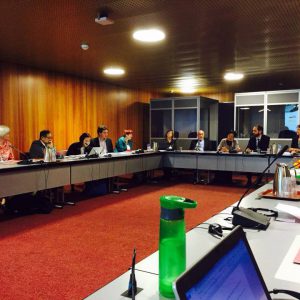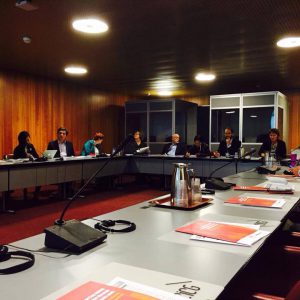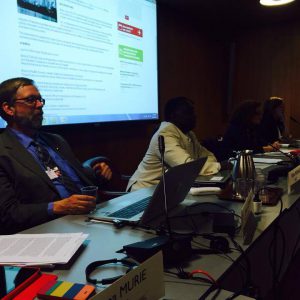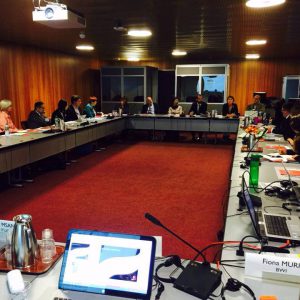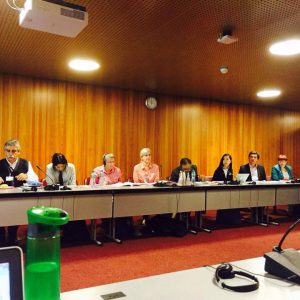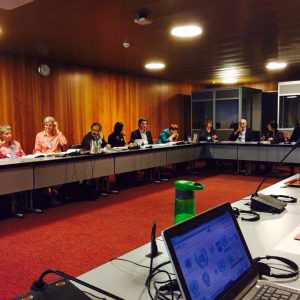Event Conference
Occupational Exposures: Experiences on advancing a more sustainable management of chemicals | ICCM4 Side Event
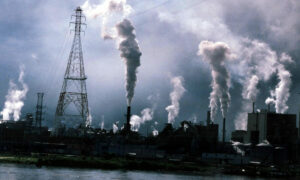
30 Sep 2015
18:15–19:45
Venue: CICG
Organization: Geneva Environment Network, International Trade Union Confederation
Side Event to the Fourth session of the International Conference on Chemicals Management (ICCM4) organized by ITUC and SustainLabour with the support of the Geneva Environment Network.
Background
Every year, the ITUC and the Global Union Federations raise awareness on a particular occupational health and safety issue. In 2015, the theme chosen was reducing toxic exposures at the workplace.
On 16 September 2015, the UN Special Rapporteur on the implications for human rights of the environmentally sound management and disposal of hazardous substances and wastes presented his first full report to the Human Rights Council on the right to information in the context of hazardous substances and wastes. Occupational exposures are one of the areas explored in this document.
The side event presented the Trade Unions campaign, their experiences around SAICM implementation and workers priorities towards 2020. It also linked to the stories shared in the Special Rapporteur Report.
Agenda
Launch of the video “Fighting toxic work”
Report to the Human Rights Council on the right to information in the context of hazardous substances and wastes
- Baskut TUNCAK | Special Rapporteur on the implications for human rights of the environmentally sound management and disposal of hazardous substances and wastes
Towards zero occupational cancer. Reducing workrelated cancer through trade union intervention
- Brian KOHLER | Director, Health, Safety and Sustainability, IndustriAll
An asbestos free world for 2020
- Fiona MURIE | Global Director of Health and Safety and Construction, BWI
Elimination of highly hazardous pesticides
- Sue LONGLEY | International Officer for Agriculture and Plantations, IUF
Making it happen: union experiences on risk reduction around the world
- Laura MARTIN MURILLO | Director, Sustainlabour
Moderation: Yahya MSANGI | ITUC
Summary
Yahya Masngi from ITUC opened the side event and announced the launcf of the Trade Unions video Fighting Toxic Work.
Laura Martin Murillo from Sustainlabour gave a brief intro to the video. She stressed tha by 2020 chemicals must be used in a way that minimizes effects on human health and therefore we must eliminate the most dangerous chemicals such as asbestos.
Special Rapporteur Baskut Tuncak – a senior attorney – said in his introduction that he had been a chemist for 10 years with substances that are now deemed dangerous by the EU, so this issue personally resonates with him. He presented part of the findings of his report. He gave the example of firefighters who when they don’t know the type of fire they are fighting, may do more harm than good, and make the problem worse. He stressed that we have a right to know of if we are being exposed to hazardous substance. This is a human rights issue. He also stressed that health and safety information should not be confidential.
Brian Kohler from IndustrialALL (presentation downloadable) made a presentation on reducing workrelated cancer through trade union intervention. He said that 80% of people that die as a result of their work is from occupational diseases and not freak accidents like it is so often advertised. He also remembered that 10% of all cancers are from work related chemicals. He then discussed the three ways carcinogens are identified, types of carcinogens and where they are found, the steps from exposure to cancer. He said that it is very difficult to pinpoint cause and effect of chemical due to latency of carcinogens – if you were exposed 10 years ago you may only see the effects now. Latency period is not a fixed period, it is over a bell curve, you may experience it earlier or later.
He remembered the basics of epidemiology: Gather information, analyze, reach conclusion. Workplace mapping techniques are helpful, speaking directly with the workers. It is very difficult to track illnesses of workers because they may have been wrongfully diagnosed, for instance, mistaking it as pneumonia as opposed to something more serious. These caveats make it very difficult to map occupational exposures. There are also other variables like health of the workers, if they are smokers for instance, skew results. He stressed that we must have control for these variables. He also spoke about healthy worker effect: people who work are generally in better health than those who don’t, so people argue that a chemical worker’s lifespan is longer than one who is unemployed. Management culture rewards risk taking, but what is an acceptable risk? Workers have the right to be part of that risk assessment process because they are the ones to face it. It is often better to take a precautionary approach than a risky approach.
Fiona Murie from BWI spoke about and asbestos free world for 2020. She recalled that asbestos is the biggest industrial killer of all time, environmental as well. Hazards are well known but still not banned worldwide due to powerful industry lobbying. It is still being mind and exported in Russia, Kazakhstan, and Brazil to be used in building materials, particularly asbestos cement. She said 47,000 people/year are dying of cancers by asbestos. At its peak, there were 5 million metric tons being produced and production has now been brought down to 2 million metric tons. She detailed the four main action areas BWI are working on:
- To protect workers from exposure to asbestos, focusing not only on a ban but what happens after a ban. Existing asbestos found in buildings.
- To promote the rights of people who are affected by exposure to asbestos. Trade unions are supporting victims groups and giving them a voice, putting them in touch with sympathetic medical and legal professionals.
- To address importing countries of the chemical to use alternative materials for construction; use less hazardous products. Address countries importing asbestos-containing materials.
She then spoke about the international consensus on stopping new use of asbestos. Asbestos abatement is very costly which is a challenge. In Asia it is guaranteed to cause an epidemic of millions of deaths in the future. It is a major problem in industrial and developing countries – it is still found in old buildings in developed countries. She finally stressed that the Rotterdam convention is underrated for its effectiveness with regards to this issue.
The moderator, Yahya Msangi, from ITUC, introducing the next speakers, stressed that numerous young girls work in the flower and plant industry in developing countries. They have collapsed at work, had various health issues. These flowers also represent sexual abuse, these women’s supervisors are men, who sexually assault them. He remembered that many of these flowers are exported to Europe and North America and asked the audiance to think twice before giving a loved one a flower.
Sue Longley from IUF (presentation downloadable), spoke about the elimination of highly hazardous pesticides. She explained that IUF doesn’t represent farmers but the people who work for the farmers, like the women Yahya spoke about. Conditions of tea plantations are appalling, workers are unprotected from the chemicals. IUF produced a study on the use of Paraquat (the most toxic of pesticides) in India for Rotterdam Convention. Retailers sell this chemical in plastic bags. Gloves have holes in them. They wear boots but very little protective clothing. She said protective equipment is not used because it’s too expensive, inaccessible, they don’t know it exists, not designed for their climate, unavailable on local markets. She stressed that agricultural workers don’t have a choice in the matter. She concluded that concerted, coordinated action to phase out HHPS within a greed timeframe is needed to ban the most toxic pesticides, top of the list being Paraquat.
Laura Martin Murillo from Sustainlabour spoke on union experiences on risk reduction around the world. One of the issues they have been working on intensively has been management of chemicals, in many regions, notably areas in Latin America. Projects were run by trade unions which drove their success. They worked on raising awareness for workers to know the substances they were using and providing them with the proper tools to fulfill the right to know. What they found is that they did not only have to introduce this to the trade union agenda, but ministry of labor agenda, and ministry of industry agenda. They created spaces for national dialogue on this topic, but were not successful in bringing industries to this dialogue.
However their project has been successful, as they have representatives trained on this issue, they know where to find information. They included the issue in some collective agreements, and have some experiences on substitution. However, they thought this information would be easy to find but it has proven to be very difficult. They are very far to have the right to know close to reality in Latin America. Meaningful resources are needed in developing countries, very few studies are available on this topic, and there are no proper statistics.
Photos
Documents
- Invitation
- Identifying Workplace Carcinogens | InduriALL
- Elimination of highly hazardous pesticides | IUF

